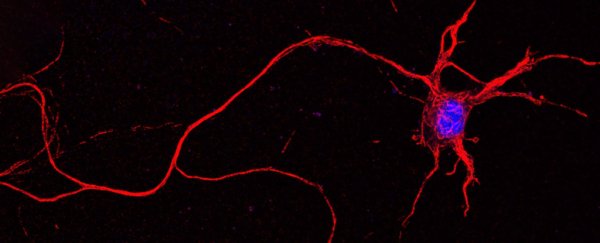Our neurons talk in melodies; understanding their rhythms has proved key to creating a new device that could join their conversations.
Just as glasses can aid our struggling eyes, the hope is that artificial brain matter could one day aid our brain bits that aren't working as well as they could be.
An international team of researchers has developed a neuroprosthetic that uses light as its communication medium, unlike previous devices used to communicate with neurons that speak in electrical outputs. This technique is called optogenetics, and provides greater targeting control than seen so far in electrical-based equivalents.
"Advances in optogenetic technology allowed us to precisely target neurons in a very small area of our biological neuronal network," said biomedical engineer Timothée Levi from The University of Tokyo.
Optogenetics involves modifying the biological neurons as well. The three to four-week-old, lab-grown biological neural network was genetically engineered to produce light-sensitive proteins derived from algae that trigger neurons to respond when exposed to blue light.
Scientists can quite precisely choose which type of neuron or location of a neural network to modify with these opsin proteins.
The researchers used the artificial neural network to produce binary rhythms of blue light targeting an area 0.8 by 0.8 millimetres within the larger biological network. The biological neurons responded through changes to their own rhythm locally as well as across the entire network. Their response was captured using calcium imaging and electrode sensors.
 (Institute of Industrial Science, The University of Tokyo)
(Institute of Industrial Science, The University of Tokyo)
"The key to our success was understanding that the rhythms of the artificial neurons had to match those of the real neurons," Levi explained.
"Once we were able to do this, the biological network was able to respond to the 'melodies' sent by the artificial one."
As the electrode array the team used to sense the neural response was four times larger than the area stimulated, the researchers point out it is likely they did not capture their full response.
Still, the experiments provide important information for creating efficient neuroprosthetic communication, the team wrote in their paper, explaining that their ability to target a very small group of neurons promises higher information transmission for future devices, possibly even down to the single neuron level.
While some people have ambitious dreams of bio-hybridly enhanced humans (transhumanism), we're still a long way from that yet.
Descendants of these artificial neurons have the more practical potential to explore neurological problems, and perhaps, one day, assist those who have experienced traumatic brain injuries. But they still have many melodies to share before we can reach that stage.
This research was published in Scientific Reports.
